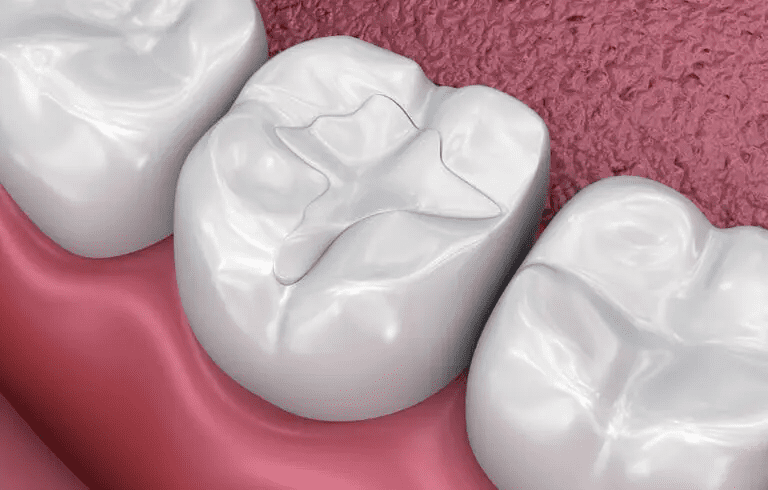How long do tooth fillings last? In exploring the durability of tooth fillings, it’s important to understand that their lifespan can vary widely depending on several factors. Generally, fillings can last for many years, but their longevity is influenced by the material used and the wear they are subjected to.
Types of Tooth Fillings
The durability of tooth fillings can vary significantly based on the materials used. Common materials include amalgam, which is an alloy of mercury, silver, copper, tin, and sometimes zinc; composite resins, which are a mixture of plastic and fine glass particles; gold; and ceramic. Each material has its own set of characteristics that affect the longevity and performance of the filling. Amalgam fillings are known for their strength and durability, often lasting 10 to 15 years or more. Composite fillings, while aesthetically pleasing due to their ability to match the color of natural teeth, typically have a shorter lifespan, usually around 5 to 10 years.
Gold fillings are considered one of the most durable options, with many lasting 20 years or more, but they are also among the most expensive. Ceramic fillings, similar to gold, offer excellent durability and can last 15 years or more, but like gold, they come at a higher cost. The choice of material not only impacts the durability of tooth fillings but also influences the overall treatment process and outcome. For more detailed information on the procedure itself, you might want to read about How long do tooth fillings take? Time Required for Dental Filling Procedures.
Average Lifespan of Fillings
The durability of tooth fillings can vary significantly based on the material used and the individual’s oral habits. Generally, amalgam fillings, which are made from a mixture of metals, can last between 10 to 15 years. Composite fillings, which are designed to match the color of your teeth, typically have a shorter lifespan, usually around 5 to 7 years. It’s important to note that these are average estimates and the actual lifespan can differ based on several factors including the location of the filling and the level of care the teeth receive.
For those considering their options for dental fillings, it’s crucial to discuss with a dental professional to understand which materials might best meet your needs. If you’re looking for more information on different types of fillings, consider visiting Affordable Tooth Fillings in Woodstock for further details.
Factors Affecting The Durability of Tooth Fillings
The durability of tooth fillings can vary widely, influenced by several key factors. Material composition plays a crucial role, as different substances such as amalgam, composite, or ceramic each have unique properties that affect longevity. Additionally, the location of the filling in the mouth and the function of the tooth—whether it’s a molar bearing the brunt of chewing forces or a front tooth used less rigorously—can impact how long the filling lasts. Personal habits, such as teeth grinding or consuming hard foods, also play a significant role in the wear and tear of dental fillings. Overall, understanding these factors can provide insight into the expected durability of tooth fillings.
Signs of Filling Wear
Over time, the durability of tooth fillings can be compromised through normal wear and tear. Common signs that your dental fillings may be wearing out include increased sensitivity in the filled tooth, noticeable cracks or chips in the filling, or a feeling of roughness when you touch the filling with your tongue. Additionally, if you start to see the edges of the filling pulling away from the tooth, or if there is a change in color, these could also be indicators that the filling material is deteriorating. Regular check-ups are essential to monitor the condition of your fillings. For professional dental care, consider visiting Woodstock Dentist.
Impact of Oral Hygiene
The durability of tooth fillings can be significantly influenced by an individual’s oral hygiene practices. Maintaining a consistent routine that supports oral health is crucial, as it directly affects the condition and longevity of dental fillings. The environment within the mouth, including the presence of bacteria and the frequency of acidic exposures, can impact the structural integrity of fillings over time. Consequently, the overall upkeep of oral cleanliness plays a pivotal role in the lifespan of these dental restorations.
Role of Dental Visits
Regular dental visits play a crucial role in the durability of tooth fillings. By scheduling routine check-ups, your dentist can monitor the condition of your fillings and address any issues before they escalate. These visits allow for early detection of wear and tear, which is vital for maintaining the integrity and longevity of your dental work. Additionally, professional cleanings help prevent plaque buildup, which can undermine the durability of tooth fillings. Thus, consistent dental care is essential to ensure your fillings last as long as possible.
Consequences of Worn Fillings
When tooth fillings become worn or damaged, it can significantly impact the durability of tooth fillings and overall dental health. Worn fillings fail to protect the tooth from bacteria and debris effectively, leading to issues such as tooth decay and infection. Additionally, damaged fillings can cause discomfort or pain, especially when eating or drinking hot or cold items. If not addressed promptly, this can necessitate more extensive and costly dental procedures, such as root canals or crowns, to restore the tooth’s integrity and function. Regular dental check-ups are crucial to assess the condition of fillings and prevent these potential consequences.
Common Reasons for Replacement
When discussing the durability of tooth fillings, it’s important to understand why they may need to be replaced over time. Several factors can reduce the lifespan of a filling, including tooth decay developing around the filling, wear and tear from biting and chewing, and possible breakage or cracking of the filling material itself. Additionally, habits such as teeth grinding or clenching can also compromise the integrity and durability of tooth fillings, necessitating their replacement to maintain oral health and functionality.
Filling Longevity and Diet Influence
The durability of tooth fillings can vary significantly based on the material used and your dietary habits. Generally, amalgam fillings can last between 10 to 15 years, while composite resin fillings might need replacement every 5 to 7 years. Consuming hard or sticky foods can shorten this lifespan by causing fillings to crack or dislodge. Additionally, frequent exposure to acidic foods and beverages can erode both the filling material and the surrounding tooth structure, further impacting the longevity of your dental work. By understanding these factors, you can take proactive steps to extend the life of your tooth fillings.
Conclusion
Understanding the durability of tooth fillings is crucial for maintaining oral health. For further inquiries, call us at 678-483-5999 or read our reviews on Google Maps.






